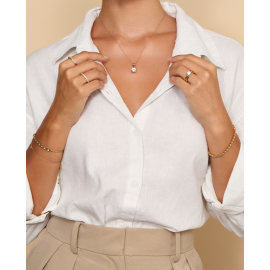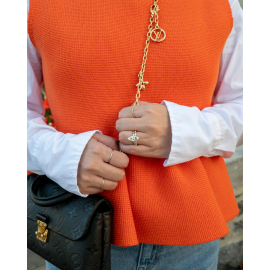What is diamond clarity
and what does it mean?
Diamond clarity is the assessment of imperfections within a diamond. Those with the least amount of defects will have a higher clarity grade and, in turn, will be valued significantly higher. Flaws to the surface of the diamond are called blemishes, and internal defects are known as inclusions. Understanding diamond clarity is crucial for evaluating diamond quality and ensuring you choose a diamond that perfectly suits your preferences.
What are diamond blemishes?
Diamond blemishes are surface imperfections found on the exterior of a diamond. These imperfections can occur naturally or as a result of cutting and polishing. Blemishes are generally less significant than inclusions but they can still impact a diamond's appearance and value.
What are diamond inclusions?
Diamond inclusions are natural flaws found within a diamond. They can appear black, grey, or white in appearance. Inclusions are created naturally due to extreme heat and pressure within the Earth's mantle during diamond formation. Diamonds can take between one to three billion years to grow within the Earth, so the chances are low of finding a perfect one, which is why flawless diamonds are rare and valuable. Inclusions are typically more significant than blemishes because they can affect the diamond's clarity, brilliance, and overall quality.

How are diamond blemishes and inclusions formed?
Diamond blemishes and inclusions are formed due to various natural processes and human activity. Blemishes often result from the cutting and polishing of the diamond, while inclusions are formed during the diamond's natural growth under the earth's surface. Understanding how these imperfections form can help you appreciate the unique characteristics of each diamond and allow you to choose the best stone for your diamond earrings, diamond engagement rings, and more.
Types of diamond blemishes
- Scratch
- Nick
- Chip
- Pit
- Abrasion
- Natural
- Polish Lines
- Extra Facet
Types of diamond inclusions
- Feather
- Cloud
- Crystal
- Pinpoint
- Graining
- Needle
- Knot
- Cavity

How to measure diamond clarity
Diamond clarity is measured by assessing imperfections under 10x magnification which is the standard for grading diamond clarity. Several factors are taken into consideration when diamond clarity such as:
- Size: How big the imperfections are.
- Number: The quantity of imperfections.
- Position: Where the imperfections can be found.
- Nature: The type of imperfection (e.g. feather or cloud)
- Relief: The contrast between the imperfect and diamond.
Diamond clarity scale chart
The Gemological Institute Of America (GIA) uses the GIA Diamond Clarity Scale to assess a diamond’s clarity. The GIA clarity scale ranges from I (included) to FL (flawless) and includes subgrades that provide more information about the visibility of inclusions in the diamond. Each grade reflects the visibility and size of inclusions under 10x magnification, and these factors determine the overall rarity and value of the diamond.

FL - Flawless
Flawless (FL) diamonds have no blemishes or inclusions visible under 10x magnification. Diamonds graded as Flawless are very rare as inclusions are naturally occurring.

IF - Internally Flawless
Internally Flawless (IF) diamonds have no visible inclusions under 10x magnification.

VVS1/VVS2 - Very Very Slight Inclusion
Very Very Slight Inclusion (VVS1/VVS2) diamonds have only slight inclusions that are difficult for a skilled grader to see under 10x magnification.

VS1/VS2 - Very Slight Inclusion
Very Slight Inclusion (VS1/VS2) diamonds have minor inclusions that can be seen with effort under 10x magnification.

SI1/SI2 - Slight Inclusion
Slight Inclusion (SI1/SI2) diamonds have noticeable inclusions under 10x magnification.

I1 - Inclusion
Inclusion (I1) diamonds have inclusions that are obvious under 10x magnification. The inclusions affect the diamond's brilliance and transparency.
Diamond colour and clarity
Diamond colour and clarity are very different. Diamond clarity refers to the imperfections within a diamond, whereas diamond colour refers to the shade or hue of a diamond. Although they are assessed differently, clarity and colour can work harmoniously together to achieve the perfect diamond. For example, a small amount of colour within a diamond can be a good thing, as it can help mask any inclusions it may have.

FAQs
Clarity significantly affects a diamond's brilliance and value. Higher clarity grades mean fewer imperfections, leading to greater light reflection and brilliance. Conversely, lower clarity grades can result in a duller appearance due to inclusions and blemishes obstructing light.
Both clarity and colour are important, but their importance will vary on personal preference. If you want a diamond with fewer visible imperfections, then you should prioritise clarity. But if you want a diamond with a pure and colourless appearance, then prioritise grade. As you compare options, remember to find a good balance between both factors to find the best diamond possible.
But setting colour and clarity aside, it's also important to note that diamond shapes can affect the visibility of inclusions and imperfections. Some shapes are better at hiding inclusions while others may make them more visible, so make sure to consider this factor as well.
A good diamond clarity grade typically falls within the "Very Slightly Included" (VS1 and VS2) range. These diamonds have minor inclusions that are not easily noticeable to the naked eye, so they offer a good balance between quality and value.
Nearly all diamonds have some sort of blemish or inclusion. These imperfections are a natural result of the diamond’s natural formation process but the size, number, and visibility of these imperfections vary from stone to stone. Flawless diamonds, which have no inclusions or blemishes that are visible under 10x magnification are extremely rare, and this is the reason they’re valued so highly.
Shop with
Diamonds Factory
Understanding diamond clarity is essential when selecting the perfect diamond for your jewellery. At Diamonds Factory, we want our customers to make the best purchase possible, and so we’ve prepared diamond educational guides that cover important topics such as cuts, carat weight and more. Taking some time to review these guides will ensure that you find the perfect diamond for your jewellery.
With that said, feel free to explore our site to view our wide selection of diamond jewellery and join us @diamondsfactoryworld to stay updated on our latest collections and promotions












